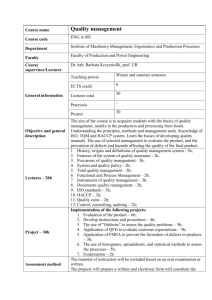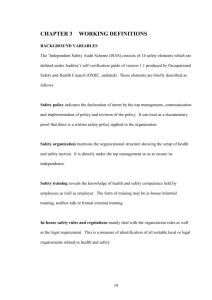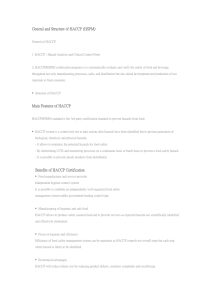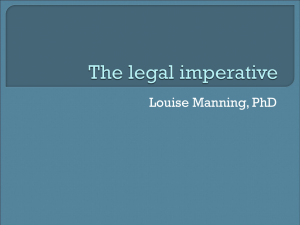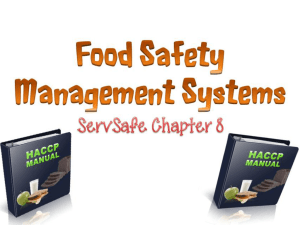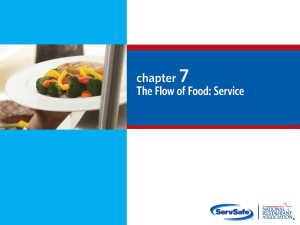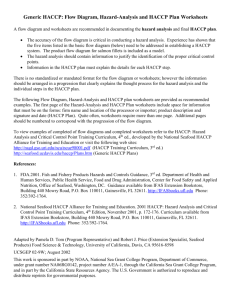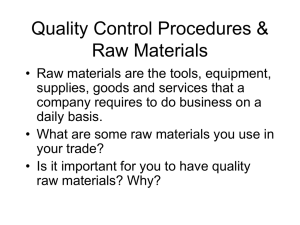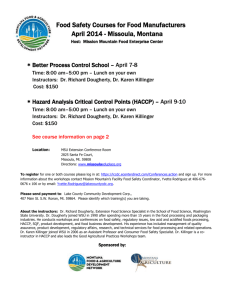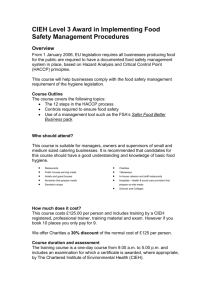Food Hygiene Questions - Cambridge University Press
advertisement
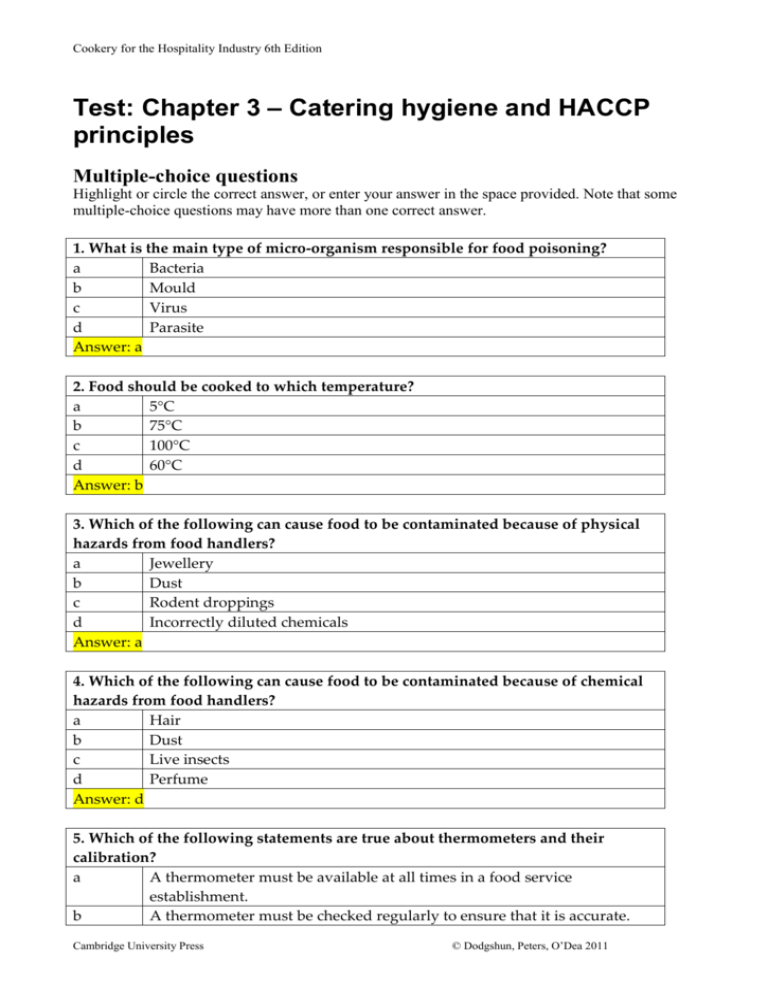
Cookery for the Hospitality Industry 6th Edition Test: Chapter 3 – Catering hygiene and HACCP principles Multiple-choice questions Highlight or circle the correct answer, or enter your answer in the space provided. Note that some multiple-choice questions may have more than one correct answer. 1. What is the main type of micro-organism responsible for food poisoning? a Bacteria b Mould c Virus d Parasite Answer: a 2. Food should be cooked to which temperature? a 5°C b 75°C c 100°C d 60°C Answer: b 3. Which of the following can cause food to be contaminated because of physical hazards from food handlers? a Jewellery b Dust c Rodent droppings d Incorrectly diluted chemicals Answer: a 4. Which of the following can cause food to be contaminated because of chemical hazards from food handlers? a Hair b Dust c Live insects d Perfume Answer: d 5. Which of the following statements are true about thermometers and their calibration? a A thermometer must be available at all times in a food service establishment. b A thermometer must be checked regularly to ensure that it is accurate. Cambridge University Press © Dodgshun, Peters, O’Dea 2011 Cookery for the Hospitality Industry 6th Edition c d Answer: A thermometer must be accurate to 1°C. All of the above Cambridge University Press © Dodgshun, Peters, O’Dea 2011 Cookery for the Hospitality Industry 6th Edition 6. At what temperature should dishware be rinsed? a 60°C b 75°C c 83°C d 89°C Answer: c 7. Sanitising is: a Applying detergent to a clean surface b Done before washing c Reducing bacteria by application of heat or chemical d Wiping all surfaces with a clean cloth Answer c: 8. Cross-contamination of food occurs when: a Cleaning and sanitising equipment and benches b Keeping food stored in food-grade containers c Washing hands before handling food d Using food handling gloves for handling money Answer: d 9. Which of the following are allergens? a Sources of gluten b Fruits and vegetables c Fish and fish products d Red meat Answer: a and c 10. Which of the following is a nutrient claim that must be substantiated if the claim is questioned? a Low-fat mince b Cholesterol-free c High in fibre d All of the above Answer: d Cambridge University Press © Dodgshun, Peters, O’Dea 2011 Cookery for the Hospitality Industry 6th Edition True or false questions Highlight or circle the correct answer, or enter your answer in the space provided. Answer true or false about storage of food 1. Safe food and quality safe food are free from True visible and invisible contamination. 2. Bain-marie should only be used to keep hot True food hot. 3. The temperature of the bain-marie should be True 60º C or higher. 4. Food should be cooled down within 2 hours, True from 21º C to 5º C. 5. Food in a freezer should be kept at –18º C or True below. 6. The temperature in a dry store should be True between 11º C and 18º C. 7. Raw food should be stored on the higher True shelves in the kitchen cold room. 8. Cold temperatures can be relied upon to True destroy many bacteria. 9. If potentially hazardous foods are to be True displayed or sold hot, they must be kept at a temperature of 30° C or higher. Answers: True, True, True, False, True, True, False, True, False Answer true or false about sanitisation and hygiene 10. All food contact surfaces, equipment and utensils must be cleaned and sanitised when they become contaminated. 11. The purpose of detergent, which is a chemical product, is to kill bacteria. 12. Use the same cloth to wipe benches utensils and crockery. 13. Cross-contamination is when bacteria contaminate food or a food surface. 14. A food-safety program is a written document that shows the staff roster. 15. Frozen foods do not contain bacteria. Answers: True, True, False, True, False, False False False False False False False False False False True False True False True False True False True False True False Short-answer questions Enter your answer in the space provided. 1. Define ‘quality safe food’. Safe food is food that is free from visible contamination or spoilage. Quality safe food must also be free from ‘invisible’ contamination by microbes such as bacteria and mould, which may cause illness or produce dangerous spores or toxins. Cambridge University Press © Dodgshun, Peters, O’Dea 2011 Cookery for the Hospitality Industry 6th Edition 2. Name 4 possible ways by which the food can become contaminated. Inadequate cooking; inappropriate holding temperatures; cross-contamination; poor personal hygiene; chemical and physical contamination 3. Why does microbial food contamination occur? Through poor food-processing systems before the food items are received into store. By contact with unclean surfaces in food preparation areas (floors, benches, slicers, knives). Through contact with domestic animals, insects or rodents, cockroaches, flies or rats. By cooks and other food handlers who neglect to wash their hands and who have a low standard of personal hygiene. By raw food coming into contact with cooked food (raw meat and unwashed vegetables or fruits). 4. Describe the type of environment in which bacteria grow well. Suitable foods (sugars, alcohols and amino acids as sources of energy, foods that are low in carbohydrates and fats). Sufficient moisture (bacteria mostly require higher water activity levels for growth than moulds). Favourable temperatures (body temperature is ideal). Time (if the above conditions are right, the number of bacteria present in food can double approximately every 20 minutes). Near-neutral pH (acid/alkali conditions). 5. What are the three types of contamination that can occur? Provide a brief explanation of each type of contamination. Food can become contaminated with physical hazards from food handlers (e.g. jewellery, hair), cleaning activities (steel wool, scourers and cloths), premises (dust, flaking paint), faulty equipment (nuts, bolts, screws and filings), insects and vermin (dead or live insects, rodent droppings) and from the food itself (seeds or stones that may be present in the raw foods). Food can become contaminated with chemical hazards from poor cleaning practices (e.g. incorrectly diluted chemicals), incorrectly stored chemicals (storing chemicals in food containers), food handlers (perfumes) and the use of inappropriate chemicals in the premises and equipment (diesel-powered forklifts in a stores area, non food-grade lubricants in equipment). 6. What are some measures that can be taken to ensure personal hygiene standards are met? Some general tips include: Shower/bath and change clothing daily. Shampoo hair regularly, ensure your hair brush is kept clean and you wear clean head coverings (especially if your hair is long). Keep hands and fingernails clean, and ensure any sores or cuts are disinfected, cleaned and covered with a waterproof dressing and/or wear surgical gloves when handling food. Keep fingernails short and clean. Clean, well fitting shoes should be maintained and used for work only (do not wear your work shoes unless you are at work). Cambridge University Press © Dodgshun, Peters, O’Dea 2011 Cookery for the Hospitality Industry 6th Edition Ensure teeth are clean and maintained. Wash your hands thoroughly with soap and hot water, and dry your hands with a paper towel or air dryer (do not use old linen cloths lying around – your hands may be just as dirty when you have finished drying them as they were before you washed them). Wash your hands regularly! You should wash your hands: before starting work after a work break when you have been to the toilet after handling anything dirty or unwashed after handling garbage or chemicals after handling uncooked food and before handling food that is ready to eat after smoking after using a tissue or touching your hair, face, body. Do not smoke where food is stored, prepared or served (workplaces usually have a designated smoking area outside the building). Avoid wearing jewellery or watches. 7. What is an allergen? An allergen is a substance that can cause illness through eating it or having contact with it. 8. What is HACCP? Hazard Analysis and Critical Control Points. HACCP predicts what could go wrong with the safety of food. It is a proactive system that aims to prevent, control and/or eliminate potential hazards. 9. What are the seven principles of HACCP? Principle 1 – Conduct a hazard analysis. Principle 2 – Determine the Critical Control Points (CCPs). Principle 3 – Establish critical limit/s. Principle 4 – Establish a system to monitor control of CCPs. Principle 5 – Establish corrective action to be taken when monitoring indicates that a particular CCP is not under control. Principle 6 – Establish procedures for verification to confirm that the HACCP systems are working effectively. Principle 7 – Establish documentation concerning all procedures and records appropriate to these principles and their application. Cambridge University Press © Dodgshun, Peters, O’Dea 2011 Cookery for the Hospitality Industry 6th Edition 10. What are the benefits of an HACCP-based food safety program? 1 HACCP is the most effective way to ensure food safety. 2 HACCP offers a simple, systematic approach to identifying and controlling hazards at all stages of the process, from purchase of ingredients through to sale or service. 3 Rather than relying on end-product testing, HACCP prevents a food safety problem from occurring in the first place. 4 HACCP provides a business with confidence in its food products and customers can feel secure about food safety standards. 5 Through identifying and controlling hazards that can affect food safety and by improving food-processing systems, the overall quality of food products is enhanced. 6 HACCP helps the business comply with Australian and international legal requirements. 7 The implementation of HACCP can support a ‘due diligence’ defence for the business if food safety problems do occur. (i.e. a legal defence that shows a business has taken all reasonable precautions and exercised all due diligence to avoid the occurrence of a foodborne incident). 11. List five areas of typical Critical Control Points requiring steps to prevent, eliminate or reduce hazards in a food service environment. Receiving, mixing, preparation, cooking, cooling, re-heating, hot and cold holding 12. What are the basic steps in cleaning dishes, utensils and equipment? Put away food before starting to clean floors and walls. Rinse by pre-soaking, sweeping and wiping down a surface. Wash utensils in clean hot water (at about 60°C), using a suitable detergent and brushes. Rinse in very hot water (at least 82°C) or use a chemical sanitiser. Air-dry. Dismantle equipment and wash the parts in a sink, wipe down fixed parts with a clean cloth. 13. Who should be part of a HACCP team? A typical HACCP team may consist of the executive chef, restaurant manager, sous chef, porter and kitchen assistants. 14. What is the purpose of the HACCP team? The HACCP team has to develop the HACCP plans (FSP) and to implement it into the operation. 15. How is the food-safety program communicated? Leading by example; regularly communicating with staff; on and off-the-job training sessions; presenting the information in a way that is easy and simple to follow. Cambridge University Press © Dodgshun, Peters, O’Dea 2011
